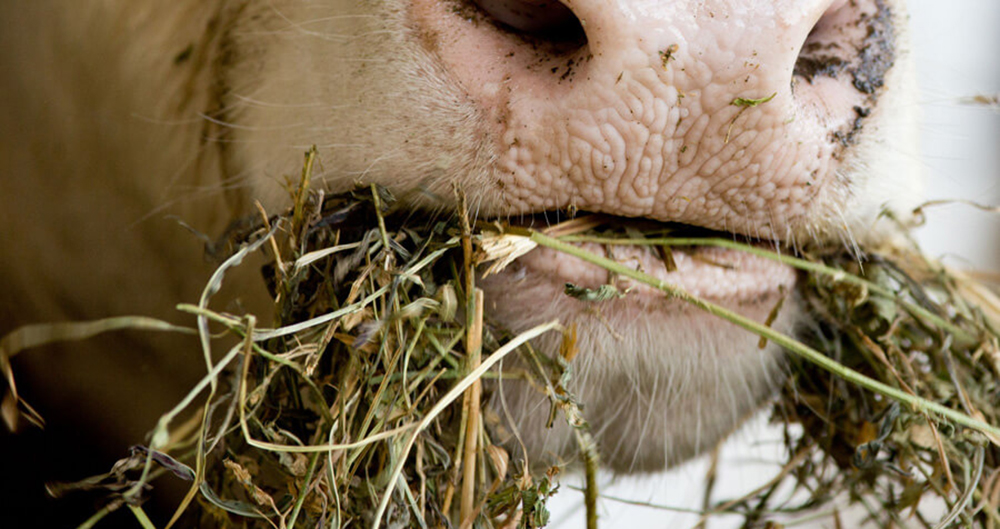Benefits of feeding long-stem hay especially when weaning calves
Like a car with a bad engine, an animal with poor gut health is going to struggle to make it, let alone be a profitable investment for the ranch. This is true with any animal but especially in weaned calves. One of the key tools you have on your ranch that can really be the launching pad to great gut health is long-stem hay.

Arguably the largest benefit of long-stem hay is the chewing requirement which stimulates salivation. Saliva is second only to teeth in the whole digestion process and can help get animals on and keep them on feed. Saliva is often overlooked, but it plays a very key role in the overall digestive processes including nutrient breakdown. An adult cow will produce between 10 to 45 gallons of saliva per day depending on what type of feedstuff is being consumed and the amount of time spent ruminating. Long-stem hay increases saliva production because of increased rumination activity, whereas short-chopped feedstuffs reduce the amount of saliva produced. Not only does saliva act as a lubricant and softener for the feed to get into the rumen, but it provides several benefits to the rumen once it arrives.
5 other benefits of feeding long-stem hay
- Feeds the good bugs in the rumen – These microorganisms do the bulk of the work in the digestion process and they need to eat too!
- Increases enzymatic activity – This is critical for breakdown of starches and tough feeds.
- Increases Nutrient absorption – Keeping things fluid in the rumen is so critical for getting nutrition into the bloodstream where it can actually impact health.
- Balances pH in the Rumen – Ultimately creating the optimum digestive environment
- Helps prevent bloat – Acts as an anti-foaming agent
Another huge benefit of long-stem hay, and a much more visible and tangible benefit is how the animals intake and digest it. Feeding long-stem hay lengthens the whole digestion process allowing the good bugs to capture more nutrition from it before it goes out the back end.
Long-stem hay VS. short-chopped hay
Dr. Lalman of Oklahoma State University shared a very interesting study with me where they compared the maintenance requirements of cows eating long-stem hay as compared to short-chopped hay. Here is what they found:
“The cows eating short-stem hay consumed 2.5% of their bodyweight in Dry-Matter intake and the cows eating long-stem consumed 1.8% of their bodyweight in Dry-Matter intake and retained the same body condition.”
-Dr. Lalman of Oklahoma State University
Here is an example to illustrate Dr. Lalman statement:
For a 50-head herd of 1,200 lb (544 kg) cows
- 2.5% of bodyweight = 30 lb (approx 13.6 kg) of hay/day
- 1.8% of bodyweight = 21.6 lb (approx. 9.5 kg) of hay/day
8.4 lb (3.8 kg) saved per cow per day= 28% hay savings
8.4 lb (3.8 kg) x 50 cows = 420 lb (190.5 kg) of hay saved per day
420 lb (190.5 kg) x 150 days = 31.5 ton (28,500 kg) of hay or around 50 bales saved!
Whether you are maintaining cows or starting calves in the lot, you should rethink how you feed your hay.
Achieve massive savings by carefully choosing how you feed out your hay

Putting it through a processor that chops the hay into short stems not only requires a lot of time, fuel, and equipment maintenance but it also significantly reduces the nutritional quality through leaf/grain loss.
Throwing whole bales into a hay feeder or hay ring is far too wasteful and increases food competition. Ideally, you should evenly distribute your forage in its original long-stem state to give every animal equal access to feed and maximum benefit from the feed.
Many feedlots and ranches are utilizing the Hustler’s Chainless processor which allows you to do all of the above while reducing your capital and operational costs of feeding. I would urge you to consider the benefits above and apply the numbers to your own operation as it is critical to helping you predict your profitability for the year.


























